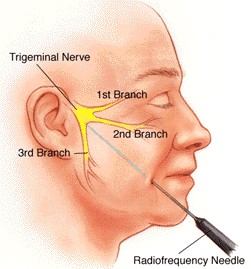PERCUTANEOUS STERIOTACTIC RADIOFREQUENCY RHIZOTOMY ELECTROCOAGULATION SURGERY IN INDIA
Once the needle is in place the curved electrode is advanced through it. By rotating the curved tip and advancing the electrode the surgeon locates the specific division of the trigeminal nerve causing the pain.

At this point the patient is awakened. A small current is applied and slowly increased until the patient’s pain is reproduced at a small level similar or less severe then that associated with the neuralgia. The patient is asked to describe the area where the sensation is felt and if this is similar in location and description to the pain that they have suffered in the past.
There is a growing arsenal of ways to treat TN, including medications and surgical treatments. The first universally accepted treatment option is usually through medications. Surgical procedures are used for those patients who are unable to tolerate the medications, exhibit serious side effects, or if the medications do not control the problem. Medications are initially effective for many patients, but over a period of time their effectiveness may diminish and a surgical procedure required.
During all phases of medical treatment, patients need good communication with their physician and nurse to monitor their medication and response. The patient must understand the need to maintain a therapeutic blood level of medication for effective pain relief. Taking the medications irregularly is not effective.
Trigeminal neuralgia (TN), also known as tic douloureux, is a pain syndrome recognizable by patient history alone. The condition is characterized by intermittent one-sided facial pain. The pain of trigeminal neuralgia typically involves one side (>95%) of face (sensory distribution of trigeminal nerve (V), typically radiating to the maxillary (V2) or mandibular (V3) area). Physical examination findings are typically normal; although mild light touch or pin perception loss has been described in central area of the face. Significant sensory loss suggests that the pain syndrome is secondary to another process, and requires high-resolution neuroimaging to exclude other causes of facial pain.














